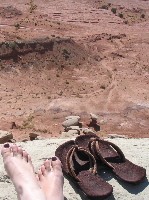 I have a friend living in Cambridge who has recently gotten into Bismuth crystal making. Unlike lead, bismuth is a surprisingly non-toxic (real) heavy element—in fact, it's the reason for the "Bism" in Pepto-Bismol. You can buy it for about $20 a pound. It melts at about 520°F, which is cool enough that you can melt it on the stove. To form a crystal, melt some bismuth on the stove (my friend uses some stainless steel bowls he's dedicated to the mission), and let the molten bismuth sit for a bit. It will begin to cool and crystalize on the surfaces (top and along the sides of the bowl); as it crystalizes, you can kind of break off pieces. It's easier to get lots of small pieces than big ones, and it takes some magic to figure out how to control the color of it—the color is due to a thin layer of bismuth oxide which forms on the surface of the crystal as it cools. If I remember correctly, gold (clearly the least interesting color when up against purple and blue) is due to too much oxidation. It is also possible to make "Bismuth eggs" (or really, "Bismuth any-kind-of-mold-you-might-have") by melting the Bismuth in a mold and then pouring out the molton Bismuth before it gets too crystalized and fills up the mold.
I have a friend living in Cambridge who has recently gotten into Bismuth crystal making. Unlike lead, bismuth is a surprisingly non-toxic (real) heavy element—in fact, it's the reason for the "Bism" in Pepto-Bismol. You can buy it for about $20 a pound. It melts at about 520°F, which is cool enough that you can melt it on the stove. To form a crystal, melt some bismuth on the stove (my friend uses some stainless steel bowls he's dedicated to the mission), and let the molten bismuth sit for a bit. It will begin to cool and crystalize on the surfaces (top and along the sides of the bowl); as it crystalizes, you can kind of break off pieces. It's easier to get lots of small pieces than big ones, and it takes some magic to figure out how to control the color of it—the color is due to a thin layer of bismuth oxide which forms on the surface of the crystal as it cools. If I remember correctly, gold (clearly the least interesting color when up against purple and blue) is due to too much oxidation. It is also possible to make "Bismuth eggs" (or really, "Bismuth any-kind-of-mold-you-might-have") by melting the Bismuth in a mold and then pouring out the molton Bismuth before it gets too crystalized and fills up the mold.
 It's difficult to tell from this perspective, but the upper-right one looks like a conical square spiral, both inside and out. The bottom right one (zoomed in below) totally looks like a Frank Gehry building, but that might be because I've seen more of Building 32 in the last weekend than I have in the last year. The two on the left were originally one piece, which was going to be a Christmas tree ornament, but it broke while spending the day in my pocket. I guess I could still glue the two pieces together (they both have relatively flat sides) and stick a piece of string in the glue as well and still end up with a nice ornament.
It's difficult to tell from this perspective, but the upper-right one looks like a conical square spiral, both inside and out. The bottom right one (zoomed in below) totally looks like a Frank Gehry building, but that might be because I've seen more of Building 32 in the last weekend than I have in the last year. The two on the left were originally one piece, which was going to be a Christmas tree ornament, but it broke while spending the day in my pocket. I guess I could still glue the two pieces together (they both have relatively flat sides) and stick a piece of string in the glue as well and still end up with a nice ornament.
UPDATE (09/13/2007): My friend has a few corrections and comments to add.
The colors: it's interference coloring, like you get on soap bubbles and oil slicks, based on how thick the oxide grows. As the layer grows in thickness, it will cycle through the colors repeatedly until the oxide gets too thick to easily transmit light, or something, and then I think it just turns gray. With the crystals, the oxide stops growing as the crystal cools. I do think I got more interesting colors when the crystals were cooler before they were exposed to air, so that they oxidized less, but I think it's a mischaracterization to say that one color or another is the result of too much oxidation.




No comments:
Post a Comment